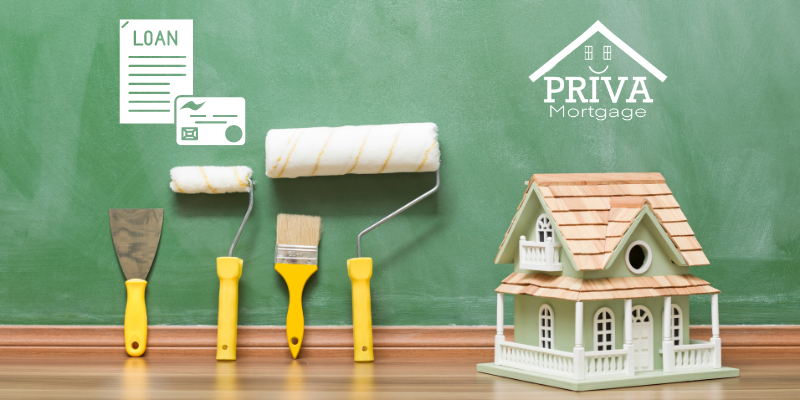Using any equity you have in your home to renovate it can be a great use of your equity. You use the funds to reinvest in your home and increase its value. But like every refinance decision, there are pros and cons to refinancing for home improvements.
Deciding if refinancing to make home improvements is right for you is a big decision.
Here’s what you must know.
How Refinancing for Home Improvements Works
When you refinance for home improvements, you do a cash-out refinance. This means you borrow more than you currently owe on your mortgage. You receive the difference between your current loan amount and the new loan amount in cash and can use the cash for home improvements.
For example, if you owe $200,000 on your current loan and your home is worth $500,000, you might borrow $100,000 for home improvements, making your new loan amount $300,000. You’ll decrease the equity in your home initially, but after you make the home improvements, your home value may increase, giving you more equity.
Pros and Cons of Refinancing for Home Improvements
All refinance decisions have pros and cons. Understanding the good and bad regarding refinancing can help you make the right decision.
Pros
- You might improve your home value – Renovating your home might increase your home’s value, giving you more equity in the home. So even though you’re borrowing more money, the renovations may more than makeup for it.
- You can use the funds how you want – There aren’t any rules regarding how you use the funds. So while using the funds for home improvements is ideal, you won’t get penalized for using the funds for something else.
- You might get a better rate or terms – When you refinance, you get new rates and terms on your loan. So, depending on your timing and qualifying factors, you might qualify for a better rate or term, saving you more money.
- You only have one payment – Using your home equity for home renovations keeps all your expenses in one loan with one payment. As a result, you don’t have to manage multiple credit cards or personal loans and their interest rates.
Cons
- You’ll pay closing costs – All refinance loans have closing costs. For the best deal, you can look at different lenders, but you’ll typically pay 2% – 5% of the loan amount in closing costs.
- You put your home at risk – If you borrow more than you can comfortably afford, you might put your home at risk. Your house is the collateral lenders use for the loan; if you miss too many payments, they could foreclose on it.
- Not all improvements increase your home’s value – There is never a guarantee that your home value will increase with the improvements. If your goal is to increase your home’s value, work with a professional appraiser or real estate agent to determine what changes would increase it the most.
Is a Cash-Out Refinance my Best Option for Home Improvements?
A cash-out refinance isn’t the only option for home improvements, but it’s usually the most cost-effective.
Other options include credit cards, personal loans, or a home equity loan. However, these options require a separate loan from your mortgage and typically charge higher interest rates.
Also Read : How to Get a Home Loan at the Lowest Interest Rate
The exception is the home equity loan or home equity line of credit. While they are a second mortgage separate from the first, the loan interest rates are usually close to what you’d get on a cash-out refinance or closer to what a bank would charge for a credit card or personal loan.
How to Qualify for a Cash-Out Refinance
Qualifying for a cash-out refinance is much like qualifying for a purchase mortgage. First, you must prove you can afford the loan to get approved. Each lender has different requirements, but here’s what most lenders require.
620 or Higher Credit Score
Lenders need to know you can afford the higher loan amount, which means they want good credit. Most lenders allow the minimum credit score 620, but you might need an even higher score to qualify.
Lenders also look at your credit history. First, they want to see that you have a solid history of paying your debts back on time. Then, they’ll look back over the last two years to determine if you are a good risk.
50% or Lower Debt-to-Income Ratio
Your debt-to-income ratio tells lenders how much of your monthly income is committed to your debts. Most lenders want a DTI of 50% or less to ensure you have enough money for your bills, daily living costs, and savings for future needs.
The debts included in your debt-to-income ratio include the new mortgage, any minimum credit card, student loan, or personal loan payments. If you pay alimony or child support, lenders will include that in your DTI too.
20% Equity
Typically, borrowers can tap into up to 80% of their home’s value. For example, say your home has a value of $300,000. You can have a loan of up to $240,000 when borrowing a cash-out refinance. You’ll receive the difference in cash between what you owe on your first mortgage and the amount you borrow with your cash-out refinance.
Final Thoughts
So should you refinance for home improvements?
It can be the best option if you qualify for a cash-out refinance. Borrowers often get the lowest interest rates, and best terms with a cash-out refinance versus any alternatives.
To help you decide what’s right, determine the total cost of any loan you borrow. Look at the interest charges, total fees, and the amount the loan will cost over its entire term. Most of the time, a cash-out refinance comes out as the most attractive option to help you renovate your home and improve its value.






